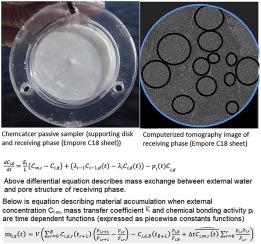当前位置:
X-MOL 学术
›
Anal. Chim. Acta
›
论文详情
Our official English website, www.x-mol.net, welcomes your
feedback! (Note: you will need to create a separate account there.)
New theory of time integrative passive samplers
Analytica Chimica Acta ( IF 5.7 ) Pub Date : 2020-08-01 , DOI: 10.1016/j.aca.2020.05.042 Janne Juntunen 1 , Heidi Ahkola 1 , Kirsti Krogerus 1 , Timo Huttula 1
Analytica Chimica Acta ( IF 5.7 ) Pub Date : 2020-08-01 , DOI: 10.1016/j.aca.2020.05.042 Janne Juntunen 1 , Heidi Ahkola 1 , Kirsti Krogerus 1 , Timo Huttula 1
Affiliation

|
Current theoretical, two compartment description of integrative passive sampling is renewed to establish a three-compartment model. The developed theoretical description includes external chemical conditions near the receiving phase, conditions inside the receiving phase and the chemically bonded compartments. New variable p, which controls the chemical bonding process into the sampler receiving phase is introduced. This new theoretical model enables derivation of equations for accumulation of masses in situations where convective mass transfer coefficient (h) and chemically bonding activity (p) are defined as a piece-wise constant functions of time. Previous two compartment model, which connects time average external concentration and accumulated mass is derived directly to the case where h and p are constants during the whole observation period. For other situations more complex equation is derived. Applicability of new equations are tested in laboratory experiments with fluctuating external chemical concentration.
中文翻译:

时间积分无源采样器的新理论
更新当前对综合被动采样的两室理论描述以建立三室模型。发展的理论描述包括接收相附近的外部化学条件、接收相内部的条件和化学键合的隔室。引入了新变量 p,它控制进入采样器接收阶段的化学键合过程。在对流传质系数 (h) 和化学键合活性 (p) 被定义为时间的分段常数函数的情况下,这种新的理论模型能够推导出质量累积方程。之前将时间平均外部浓度和累积质量联系起来的两个隔室模型直接导出到 h 和 p 在整个观测期间为常数的情况。对于其他情况,推导出更复杂的方程。新方程的适用性在实验室实验中进行了测试,外部化学浓度波动。
更新日期:2020-08-01
中文翻译:

时间积分无源采样器的新理论
更新当前对综合被动采样的两室理论描述以建立三室模型。发展的理论描述包括接收相附近的外部化学条件、接收相内部的条件和化学键合的隔室。引入了新变量 p,它控制进入采样器接收阶段的化学键合过程。在对流传质系数 (h) 和化学键合活性 (p) 被定义为时间的分段常数函数的情况下,这种新的理论模型能够推导出质量累积方程。之前将时间平均外部浓度和累积质量联系起来的两个隔室模型直接导出到 h 和 p 在整个观测期间为常数的情况。对于其他情况,推导出更复杂的方程。新方程的适用性在实验室实验中进行了测试,外部化学浓度波动。











































 京公网安备 11010802027423号
京公网安备 11010802027423号